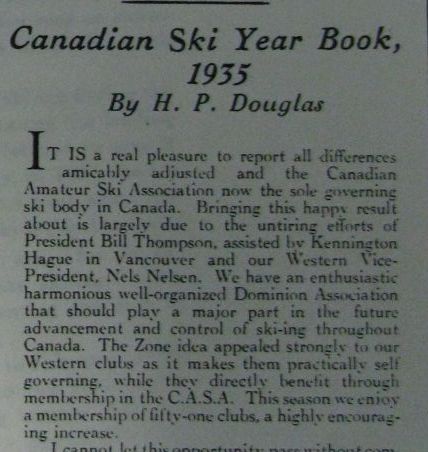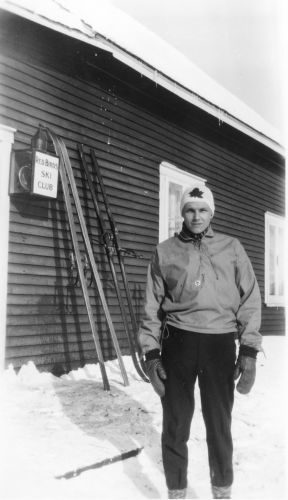The idea of a national sport governing body for skiing was originally proposed by Percy Douglas, of the Montreal Ski Club, on 28th February 1920. A small committee was formed consisting of Douglas and several representatives from a couple of Ottawa-based ski clubs. The plan was that the fledgling organization should be modelled along similar lines to the already established U.S. National Ski Association.
This idea took root – the Canadian Amateur Ski Association (CASA) was incorporated on 20th December, 1920 and held its first meeting on Monday February 19th, 1921. The inaugural member clubs were the Montreal Ski Club, the Ottawa Ski Club, the Cliffside Ski Club (also in Ottawa) and the Québec Ski Club. The organization aims were: to schedule tournament dates so as to avoid conflicts; to conduct its own annual ski competitions; to endeavour to standardize rules regarding the sport; to foster interest in skiing and to encourage the development of local clubs; and to establish a means of distinguishing between the amateur and the professional skier.
By 1925 CASA had become affiliated with the Amateur Athletic Union of Canada (AAUC) and had outlined rules for competition to be enforced by member clubs. The following year, 1926, CASA became a member of the Féderation Internationale du Ski (FIS), the international governing body for skiing.
Initially, it was only ski clubs in eastern Canada who belonged to CASA, but at the Annual General Meeting in 1928 the elected position of Western Vice-President was created so as to include western Canada. Following this meeting, several western clubs joined CASA, including Grouse Mountain Ski Club, Hollyburn Pacific Ski Club, Vancouver Ski Club, Revelstoke Ski Club, Banff Ski Club, Jasper Ski Club and Camrose Ski Club. However, over the next four or five years, some tensions developed, as evidenced in the following extract from the January 4th edition of SkWeek, a publication sanctioned by the Canadian Amateur Ski Association. The article is titled “East-West Break”:

Retyped for ease of reading:
The jurisdiction of the Canadian Amateur Ski Association over ski-ing in Canada was definitely asserted this week in the announcement made by W. B. Thompson, of Montreal, President of the Association, to the effect that Western clubs, with the exception of the Revelstoke Ski Club and the Vancouver Winter Sports Club, were no longer recognized as member clubs and that the appointment of Western Vice-President made to Nels Nelsen at the Annual Meeting last Autumn had not been accepted.
The decision of the Ski Association in this matter climaxes a long controversy between Western clubs and the governing body. It also carries with it the definite certainty that only recognized ski clubs will be permitted to send competitors to Provincial and Dominion championship meets and that the Canadian Olympic Ski Team will be selected from members of clubs in good standing. This latter development is assured as the Canadian Amateur Ski Association is recognized by the Amateur Athletic Union of Canada as the governing body for the sport.
According to W. B. Thompson all consideration has been shown Western clubs in negotiations extending back over a period of two years. A Western Canada Ski Association, having Nels Nelsen as its leader and numbering 13 clubs has been negotiating with the C.A.S.A. during the past week through the representation of K. Hague of Vancouver. The Western group demanded full equality with the C.A.S.A. which, naturally, the latter was not willing to grant as it would tend to sectionalize the sport and result in two associations controlling ski-ing. This Western association is not a recent development. It has been the bone of contention under three C.A.S.A. presidents and executives. Concessions to Western clubs have been made in the matter of membership fees over the past two years. Associate membership fees were offered to them with the privileges of full membership. A deadline was set on the payment of fees and acceptance or refusal of the C.A.S.A. regulations for the end of 1934. The action of the C.A.S.A. appears justified in view of the attitude of the Western clubs in refusing to accept the conditions laid down.
The writer of the article then goes on to clarify CASA’s position, noting that only members of C.A.S.A.-affiliated clubs will be eligible for selection to the 1936 Olympic team, which will exclude all Western skiers except those belonging to the Revelstoke or Vancouver clubs. The writer also makes the point that having all “ski-ing” under the control of one organization will be the best course of action as that organization will have “experienced and able men” at its head:
A close examination of the stand taken by the Association reveals the significant fact that the executive body emerges from the struggle in a much stronger position than the Western clubs. The selection of the Canadian Olympic Team for the 1936 Games in Germany will be made from skiers who are members of clubs belonging to C.A.S.A. Under the present set-up no Western skiers will be candidates for the Team. The exceptions to this are the Revelstoke Ski Club and the Vancouver Winter Sports Club. This ruling also applies to Provincial and Dominion championship meets. It is reasonable to suppose that many clubs will seek to return to the C.A.S.A. banner, especially as the executive body is now dealing individually with various clubs with a view to obtaining such results.
Ski-ing is becoming a national sport and the control of it is best vested in one organization with experienced and able men at the head. The C.A.S.A. through its affiliation with the C.A.A.U. is recognized as such an organization and its holdings will be respected by the latter body.
The next step in the saga was announced on 23rd February, 1935 in SkWeek, which was captioned “East Meets West” and is retyped below as the photo (also shown) is not very clear.

East Meets West
Western Clubs Affiliate with Governing Body to Climax President’s First Term
A bigger and stronger Canadian Amateur Ski Association is assured in the announcement made this week by W. B. Thompson, C.A.S.A. president, that Camrose, Vancouver, Grouse Mountain and Hollyburn Pacific ski clubs have been reinstated to membership in the Association. In addition to these clubs the Nelson, Kimberley, Trail and Rossland ski clubs are corresponding with the C.A.S.A. regarding affiliation. Two other clubs, the Vancouver Winter Sports Club and the Revelstoke Ski Club, joined forces with the C.A.S.A. last month.
With the inclusion of these Western clubs the governing body for the sport will be able to lay plans for Olympic competition with the assurance that the ski-ing fraternity is solidly organized throughout the country. The policy of the Association to the clubs which have come back to the fold will be of a friendly and politic nature. Western ski affairs will be operated by Zones, similar to those in Eastern Canada. These Zones will be composed of Western Clubs and each Zone will answer to a General Zone Chairman, preferably the Western Vice-President of the Canadian Amateur Ski Association.
The rapprochement between East and West is due in no small degree to the efforts of Kay Hague, president of the Vancouver Winter Sports Club who, in his negotiations with the ski-ing executive, displayed a tact and understanding of the problem confronting both sections of the country. In this respect he was fortunate in dealing with W. B. Thompson, C.A.S.A. president, whose diplomatic handling of controversial matters has featured his first year in office.
It is to be sincerely hoped that the progress of ski-ing under one executive body, allowing a self-governing status to various sections of the Dominion, will be characterized by harmony and tend to develop the sport to its proper position in the minds of Canadians.
On 23rd April, 1935 the matter continued to evolve: on that day a newspaper article noted that the Western Canada Amateur Ski Association passed out of existence and was replaced by a six-man advisory board, headed by Nels Nelson, the western vice-president of the CASA.
The April article is reproduced below:

In a bit of a time warp, on the same page of the 23rd February, 1935 edition of SkWeek as the “East Meeets West” article are two other articles: an extract from the C.A.S.A. minutes of the Seventeenth Annual Meeting (Western Section) dated March 4th, 1937:

Rewritten for clarity:
This is an extract from the C.A.S.A. minutes of the Seventeenth Annual Meeting (Western Section) on March 4, 1937.
Mr. Hague’s report expressed the opinion that perhaps some of the Western Clubs had felt slightly neglected in the past but pointed out that with the great improvement in the method of administration, this situation would remedy itself. He commented favourably on the growing friendship and cordiality between the Associations in Canada and the United States, and the advisability of maintaining this attitude to the best of our ability. The Zone situation is being cleared up and next season things will be run on a more satisfactory basis.
and an extract from the 1935 Canadian Ski Year Book, by H. P. Douglas:

Finally, in 1936, W. B. Thompson included the following two page article on Western Clubs in his President’s Report to CASA covering the years 1934, 1935 and 1936:


Editor’s note: Daisy Bourdon, referred to in the final paragraph above, was for many years in the 1920s and 30s the undisputed Canadian women’s champion in cross country ski racing.
Finally, below are two photographs. The first is of Percy Douglas, who was the original proponent for the formation of a Canadian national sport governing body.
The second photo is of W. B. Thompson, President of CASA during the tumultuous times described above. The photo was taken in 1930.

Percy Douglas 
W. B. Thompson
Source: The Canadian Ski Museum archives